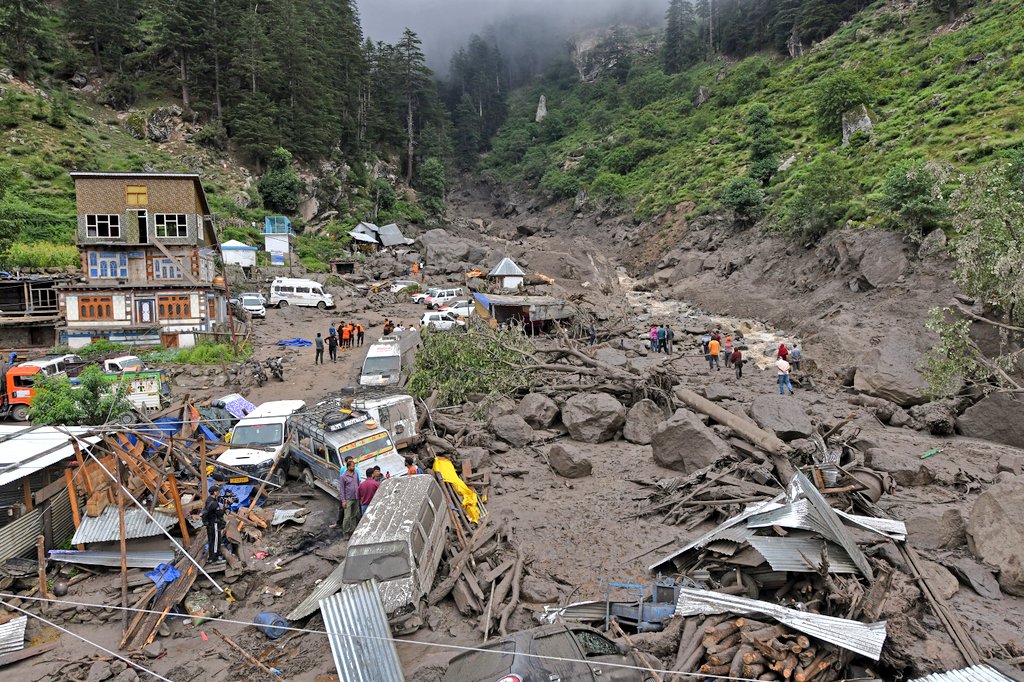What is a Cloudburst?
A cloudburst refers to an extreme weather event where intense rainfall occurs in a short period over a small area, typically more than 100 mm of rain in under an hour. These events are sudden, powerful, and highly localized, often leading to flash floods, landslides, and severe infrastructure damage, especially in mountainous or poorly drained regions.
Cloudbursts are difficult to forecast due to their small scale and rapid development. They occur when warm, moist air rises rapidly, condenses into cumulonimbus clouds, and releases torrential rainfall, often in areas with steep terrain. Climate change is further intensifying such events across South Asia.
Recent Cloudburst Disasters in South Asia
Pakistan (Gilgit-Baltistan, July 2025)
- Occurred during the night of July 15, near the Skardu region.
- Over 120 mm of rain fell in 45 minutes.
- Resulted in at least 50 deaths and hundreds displaced.
- Key roads, bridges, and communication lines were washed away.
- The emergency response was hampered by difficult terrain.
India (Ladakh & Himachal Pradesh, August 2025)
- A deadly cloudburst hit Ladakh on August 4, causing flash floods in remote villages.
- 12 people killed, dozens missing, and significant damage to homes.
- In Himachal Pradesh, multiple cloudbursts in Kullu and Mandi districts led to landslides.
- Army units deployed for search and rescue operations.
🇧🇹 Bhutan (Eastern Bhutan, July 2025)
- Heavy rain due to a cloudburst caused flooding in Trashigang District.
- Several rural settlements were affected.
- No confirmed fatalities, but significant damage to farmland and roads.
- Authorities issued advisories and relocated families in high-risk areas.
How Do Cloudbursts Happen?
Cloudbursts are typically caused by a combination of:
- Orographic Lift – Moist air is lifted over mountains and cools quickly.
- Rapid Condensation – Air cools and condenses rapidly, forming thick storm clouds.
- Atmospheric Instability – Encourages vertical cloud growth and rapid rain release.
- Lack of Wind Dispersal – Keeps clouds stationary, dumping all moisture in one place.
These factors, especially in hilly or mountainous terrain, make South Asia particularly vulnerable.
Preventive Measures and Action Steps
- Advanced Forecasting Systems – Investment in satellite and radar-based weather tracking.
- Infrastructure Upgrades – Strengthening roads, bridges, and drainage in risk-prone zones.
- Disaster Preparedness – Local training, community alerts, and clear evacuation protocols.
- Environmental Conservation – Forest cover and wetland restoration to absorb runoff.
- Public Awareness – Educating communities on early warning signs and safety actions.
The increasing frequency of cloudburst disasters in Pakistan, India, and Bhutan reflects the mounting impact of climate change on Asia’s weather patterns. While these events remain difficult to predict, greater preparedness, resilient infrastructure, and climate-focused policies are essential to minimize loss of life and damage. The region must prioritize early warning systems and coordinated response mechanisms to confront this rising threat.
আরও পড়ুন: Is ChatGPT banned in Bangladesh? Let’s check







